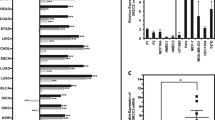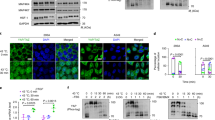Abstract
The cytomegalovirus-immediate early (CMV-IE) promoter is widely used as a strong and constitutively active promoter. Although the CMV-IE promoter does not harbor heat-responsive sequences, we determined its heat inducibility. We analyzed in vitro and in vivo heat responsiveness and possible mechanisms of heat induction of the CMV-IE promoter. We used transfected SW480 human colon carcinoma cells (SW480/CMVCD), expressing CMV-IE promoter-driven bacterial cytosine deaminase (CD) gene. These cells were heated at 42°C. The SW480/CMVCD cells were also used for in vivo studies, in which tumor-bearing animals were treated with hyperthermia at 41.5°C. As controls, SW480 (SW480/HSPCD) cells were used, in which CD expression is driven by the HSP70-promoter. In vitro, we observed a biphasic, up to 25-fold heat induction of CMV-IE-driven CD expression after hyperthermia in SW480/CMVCD cells. In vivo, we found a 2.5-fold induction of CD expression after hyperthermia in SW480/CMVCD tumor-bearing animals. The analysis of the CMV-IE promoter sequence revealed several transcription factor-binding sites, which mediate stress responsiveness. YB-1 and C/EBP-β might mediate heat responsiveness of the CMV-IE promoter. These data point to limitations in heat-induction gene therapy studies, in which the CMV-IE promoter is used as control system. In addition, the CMV-IE promoter itself could well be used for construction of heat-inducible vectors.




Similar content being viewed by others
References
Wathen, M. W., & Stinski, M. F. (1982). Temporal patterns of human cytomegalovirus transcription: Mapping the viral RNAs synthesized at immediate early, early, and late times after infection. Journal of Virology, 41, 462–477.
Stinski, M. F., Thomsen, D. R., Stenberg, R. M., & Goldstein, L. C. (1983). Organization and expression of the immediate early genes of human cytomegalovirus. Journal of Virology, 46, 1–14.
Zerbini, M., Musiani, M., & La Placa, M. (1986). Stimulating effect of heat shock on the early stage of human cytomegalovirus replication cycle. Virus Research, 6, 211–216.
Geelen, J. L., Boom, R., Klaver, G. P., Minnaar, R. P., Feltkamp, M. C., van Milligen, F. J., et al. (1987). Transcriptional activation of the major immediate early transcription unit of human cytomegalovirus by heat-shock, arsenite and protein synthesis inhibitors. Journal of General Virology, 68, 2925–2931.
Andrews, J. M., Newbound, G. C., & Lairmore, M. D. (1997). Transcriptional modulation of viral reporter gene constructs following induction of the cellular stress response. Nucleic Acids Research, 25, 1082–1084.
Bruening, W., Giasson, B., Mushynski, W., & Durham, H. D. (1998). Activation of stress-activated MAP protein kinases up-regulates expression of transgenes driven by the cytomegalovirus immediate/early promoter. Nucleic Acids Research, 26, 486–489.
Lee, Y. J., Kim, J. H., & Ryu, S. (1994). Comparison of heat shock gene expression in mild-hyperthermia sensitive human prostatic carcinoma cells and heat-resistant human breast carcinoma cells. Journal of Thermal Biology, 19, 151–161.
Lee, Y. J., Hou, Z. Z., Curetti, L. L., Erdos, G., Stromberg, J. S., Carper, S. W., et al. (1994). Regulation of HSP70 and HSP28 gene expression: Absence of compensatory mechanisms. Molecular and Cellular Biochemistry, 137, 155–167.
Lee, Y. J., Lee, H., & Borelli, M. J. (2002). Gene transfer into human prostate adenocarcinoma cells with an adenoviral vector: Hyperthermia enhances a double suicide gene expression, cytotoxicity and radiotoxicity. Cancer Gene Therapy, 9, 267–274.
Stein, U., Jürchott, K., Walther, W., Bergmann, S., Schlag, P. M., & Royer, H.-D. (2001). Hyperthermia-induced nuclear translocation of transcription factor YB-1 leads to enhanced expression of multidrug resistance-related ABC transporters. Journal of Biological Chemistry, 276, 28562–28569.
Hungness, E. S., Robb, B. W., Luo, G. J., Hershko, D. D., & Hasselgren, P. O. (2002). Hyperthermia-induced heat shock activates the transcription factor c/EBP-beta and augments IL-6 production in human intestinal epithelial cells. Journal of the American College of Surgeons, 195, 619–626.
Dorion, S., & Landry, J. (2002). Activation of the mitogen-activated protein kinase pathways by heat shock. Cell Stress Chaperones, 7, 200–206.
Imbriano, C., Bolognese, F., Gurtner, A., Piaggio, G., & Mantovani, R. (2001). HSP-CBF is an NF-Y-dependent coactivator of the heat shock promoters CCAAT boxes. Journal of Biological Chemistry, 276, 26332–26339.
Johnson, G. L., & Nakamura, K. (2007). The c-jun kinase/stress-activated pathway: Regulation, function and role in human disease. Biochimica et Biophysica Acta, 1773, 1341–1348.
Jin, S., & Scotto, K. W. (1998). Transcriptional regulation of the MDR1 gene by histone acetyltransferase and deacetylase is mediated by NF-Y. Molecular and Cellular Biology, 18, 4377–4384.
Messeguer, X., Escudero, R., Farré, D., Nuñez, O., Martínez, J., & Albà, M. M. (2002). PROMO: Detection of known transcription regulatory elements using species-tailored searches. Bioinformatics, 18, 333–334.
Farré, D., Roset, R., Huerta, M., Adsuara, J. E., Roselló, L., Albà, M. M., et al. (2003). Identification of patterns in biological sequences at the ALGGEN server: PROMO and MALGEN. Nucleic Acids Research, 31, 3651–3653.
Stein, U., Bergmann, S., Scheffer, G., Scheper, R. J., Royer, H.-D., Schlag, P. M., et al. (2005). YB-1 facilitates basal and 5-fluorouracil-inducible expression of the major vault protein (MVP) gene. Oncogene, 24, 3606–3618.
Foecking, M. K., & Hofstetter, H. (1986). Powerful and versatile enhancer–promoter unit for mammalian expression vectors. Gene, 45, 101–105.
Schmidt, E. V., Christoph, G., Zeller, R., & Leder, P. (1990). The cytomegalovirus enhancer: A pan-active control element in transgenic mice. Molecular and Cellular Biology, 10, 4406–4411.
Boshart, M., Weber, F., Jahn, G., Dorsch-Hasler, K., Fleckenstein, B., & Schaffner, W. (1985). A very strong enhancer is located upstream of an immediate early gene of human cytomegalovirus. Cell, 41, 521–530.
Jeang, K. T., Rawlins, D. R., Rosenfeld, P. J., Shero, J. H., Kelly, T. J., & Hayward, G. S. (1987). Multiple tandemly repeated binding sites for cellular nuclear factor 1 that surround the major immediate-early promoters of simian and human cytomegalovirus. Journal of Virology, 61, 1559–1570.
Karin, M., Liu, Z., & Zandi, E. (1997). AP-1 function and regulation. Current Opinion in Cell Biology, 9, 240–246.
Wang, Y., & Morgan, W. D. (1994). Cooperative interaction of human HSF1 heat shock transcription factor with promoter DNA. Nucleic Acids Research, 22, 3113–3118.
Morano, K. A., & Thiele, D. J. (1999). Heat shock factor function and regulation in response to cellular stress, growth, and differentiation signals. Gene Expression, 7, 271–282.
Walther, W., & Stein, U. (2009). Heat-responsive gene expression for gene therapy. Advanced Drug Delivery Reviews, 61, 641–649.
Cunniff, N. F., & Morgan, W. D. (1993). Analysis of heat shock element recognition by saturation mutagenesis of the human HSP70.1 gene promoter. Journal of Biological Chemistry, 268, 8317–8324.
Rohmer, S., Mainka, A., Knippertz, I., Hesse, A., & Nettelbeck, D. M. (2008). Insulated hsp70B’ promoter: Stringent heat-inducible activity in replication-deficient, but not replication-competent adenoviruses. Journal of Gene Medicine, 10, 340–354.
Kohno, K., Izumi, H., Uchiumi, T., Ashizuka, M., & Kuwano, M. (2003). The pleiotropic functions of the Y-box-binding protein, YB-1. Bioessays, 25, 691–698.
Ohtsuka, K., & Hata, M. (2000). Molecular chaperone function of mammalian Hsp70 and Hsp40—a review. International Journal of Hyperthermia, 16, 231–245.
Stephanou, A., Isenberg, D. A., Akira, S., Kishimoto, T., & Latchman, D. S. (1998). The nuclear factor interleukin-6 (NF-IL6) and signal transducer and activator of transcription-3 (STAT-3) signalling pathways co-operate to mediate the activation of the hsp90beta gene by interleukin-6 but have opposite effects on its inducibility by heat shock. Biochemical Journal, 330, 189–195.
Li, H., Gade, P., Xiao, W., & Kalvakolanu, D. V. (2007). The interferon signaling network and transcription factor C/EBP-beta. Cellular & Molecular Immunology, 4, 407–418.
Ruocco, M. R., Chen, X., Ambrosino, C., Dragonetti, E., Liu, W., Mallardo, M., et al. (1996). Regulation of HIV-1 long terminal repeats by interaction of C/EBP(NF-IL6) and NF-kappaB/Rel transcription factors. Journal of Biological Chemistry, 271, 22479–22486.
Acknowledgments
This study was duly supported by the Deutsche Forschungsgemeinschaft (grant SCHL/3-4). We thank Margit Lemm for the excellent technical assistance in performing the in vivo hyperthermia experiments.
Author information
Authors and Affiliations
Corresponding author
Rights and permissions
About this article
Cite this article
Kobelt, D., Aumann, J., Fichtner, I. et al. Activation of the CMV-IE Promoter by Hyperthermia In Vitro and In Vivo: Biphasic Heat Induction of Cytosine Deaminase Suicide Gene Expression. Mol Biotechnol 46, 197–205 (2010). https://doi.org/10.1007/s12033-010-9292-3
Published:
Issue Date:
DOI: https://doi.org/10.1007/s12033-010-9292-3




